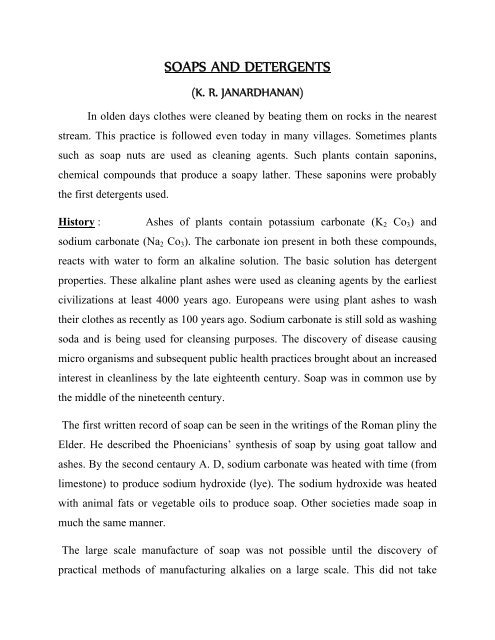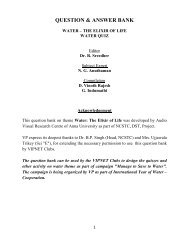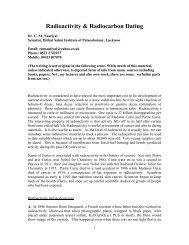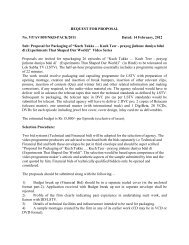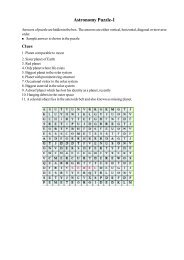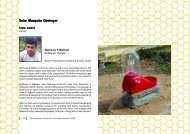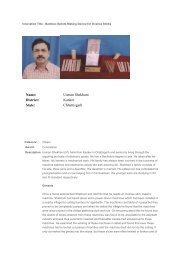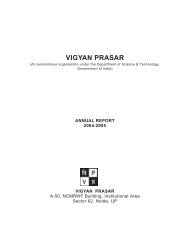SOAPS AND DETERGENTS - Vigyan Prasar
SOAPS AND DETERGENTS - Vigyan Prasar
SOAPS AND DETERGENTS - Vigyan Prasar
You also want an ePaper? Increase the reach of your titles
YUMPU automatically turns print PDFs into web optimized ePapers that Google loves.
<strong>SOAPS</strong> <strong>AND</strong> <strong>DETERGENTS</strong><br />
(K. R. JANARDHANAN)<br />
In olden days clothes were cleaned by beating them on rocks in the nearest<br />
stream. This practice is followed even today in many villages. Sometimes plants<br />
such as soap nuts are used as cleaning agents. Such plants contain saponins,<br />
chemical compounds that produce a soapy lather. These saponins were probably<br />
the first detergents used.<br />
History : Ashes of plants contain potassium carbonate (K2 Co3) and<br />
sodium carbonate (Na2 Co3). The carbonate ion present in both these compounds,<br />
reacts with water to form an alkaline solution. The basic solution has detergent<br />
properties. These alkaline plant ashes were used as cleaning agents by the earliest<br />
civilizations at least 4000 years ago. Europeans were using plant ashes to wash<br />
their clothes as recently as 100 years ago. Sodium carbonate is still sold as washing<br />
soda and is being used for cleansing purposes. The discovery of disease causing<br />
micro organisms and subsequent public health practices brought about an increased<br />
interest in cleanliness by the late eighteenth century. Soap was in common use by<br />
the middle of the nineteenth century.<br />
The first written record of soap can be seen in the writings of the Roman pliny the<br />
Elder. He described the Phoenicians’ synthesis of soap by using goat tallow and<br />
ashes. By the second centaury A. D, sodium carbonate was heated with time (from<br />
limestone) to produce sodium hydroxide (lye). The sodium hydroxide was heated<br />
with animal fats or vegetable oils to produce soap. Other societies made soap in<br />
much the same manner.<br />
The large scale manufacture of soap was not possible until the discovery of<br />
practical methods of manufacturing alkalies on a large scale. This did not take
place until about 1800. Soaps are compounds formed by the reaction of bases with<br />
fats, chemically known as fatty acid esters. The most important fatty acid esters.<br />
The three most important fatty acid esters are<br />
Palmitin [( C15 H3 1 COO)3 C3 H5)<br />
Stearin [( C17 H35 COO)3 C3 H5)<br />
and<br />
Olein [( C17 H3 3 COO)3 C3 H5)<br />
They are found in lard, tallow, olive oil, cotton seed oil, and other animal and<br />
vegetable fats or oils. Soap is usually made by the reaction of animal fat or<br />
vegetable oil with sodium hydroxide. The process of treating fats with bases or<br />
alkalies is called ‘Saponification’. Vegetable oils, with unsaturated carbon chains,<br />
produce soft soaps. Animal fats yield hard soaps. Coconut oils with shorter carbon<br />
chains, yield soaps that are more soluble in water.<br />
Soap to day : In modern commercial soap making, the fats and oils are often<br />
hydrolysed with super heated steam. The fatty acids then are neutralized to make<br />
soap. The process takes place in large cylindrical vessel. The next step in the<br />
manufacture of soap is called graining or Saltingout. This involves the addition of<br />
common salt (NaCl). During this process the soap becomes insoluble in brine and<br />
separates from the solution. The soap may be washed several times with brine to<br />
rid it of free alkali.<br />
The molten soap may be run into large frames from which bars may be cut, or it<br />
may be run over cold rollers, producing thin sheets which are scraped to form soap<br />
chips. The molten soap may also be squirted from a nozzle as a spray into hot air to<br />
form powdered soap.
Soft or liquid soaps are made by using potassium hydroxide (KOH) instead<br />
of lye. Potassium soap produces a finer lather. They are used alone or in<br />
combination with sodium soaps in liquid soaps, shampoo soaps and shaving<br />
creams.<br />
Very often certain foreign materials are added to soap as it leaves the reaction<br />
kettle. These fillers may be such inert adulterants as chalk and suphates of sodium,<br />
calcium or barium. Another very common filler is talc (magnesium acid silicate).<br />
Sodium silicate is also used. Silicates give firmness to soap and enables it to hold<br />
more water. Rosin is also sometimes added to soap especially to laundry soap.<br />
Although not a fatty acid, it reacts with sodium hydroxide to form a sodium salt<br />
which resembles soap in many respects. It is soluble and has a high frothing power.<br />
The cleansing power of rosin soap is much lower than that of ordinary soap. The<br />
presence of rosin in any quantity is undesirable. If soap contains more than 15<br />
percent rosin, it is known as low grade soap. Permitted dyes are added to soaps to<br />
impart than a pleasing colour. The most expensive ingredient of toilet soap is the<br />
perfume, which is responsible for its characterstic odour.<br />
Ads’ and soaps Among the consumer products aggressively advertised,<br />
bath soap’s are in the top of the list. Although, a both soaps basic function is to<br />
clean the body, the advertisements confer exotic qualities to it. Soaps are being<br />
advertised as<br />
- Beauty soaps - Cinema stars are their brand ambassadors<br />
- Health soaps - Sports person used to sponsor them<br />
- Complexion soaps<br />
- Deodorant soaps<br />
- Freshness soaps
- Baby soaps and<br />
- Herbal or medicinal soaps<br />
None of the advertisements speak of what exactly, goes into the making of such<br />
soaps. Can medicated soaps readily cure skin diseases? Are glycerine transparent<br />
soaps really gentle to the skin ?<br />
As mentioned earlier soaps are salts particularly sodium or potassium of long<br />
chain fatty acids. These carboxylic acids are derived from fatty oils. The principal<br />
active cleaning agent is sodium carboxylate.<br />
Total Fatty Matter (TFM)<br />
Soaps are graded in terms of total fatty matter or TFM. Bureau of Indian<br />
Standards (BIS) has catogorised bath or toilet soaps as ‘normal’, ‘baby,<br />
transparent, and antibacterial soaps. The last three are called specialty soaps<br />
targeted to specific users. A toilet soap is a cosmetic by law and it must fulfil the<br />
requirements of the relevant Indian standard.<br />
T. F. M or total fatty matter is a measure for identifying the amount of fatty matter<br />
present in soaps. TFM of a sample of soap can be determined as follows. A known<br />
weight of the soap is dissolved in water and the solution is treated with dilute<br />
sulphuric acid. The soap decomposes to sodium suplphate and fatty acids. The<br />
fatty acids so formed can be estimated. From this TFM can be calculated. On the<br />
basis TFM, toilet soaps can be classified into three grades.<br />
Grade 1 TFM Moisture Free salt (NaCl)<br />
I above 80 Max : 13.5 Max : 0.7<br />
II 65 – 80 13- 15 0.8<br />
III 55- 65 15-20 1.5
Grade I toilet soap should have TFM value above 80 percent, except in<br />
ayurvedic soap. Any soap which has a TFM value less than 55 percent is not<br />
considered as toilet soap at all. TFM is what lends soap its soapy feel and it is the<br />
TFM and the insoluble matter in the soap that largely distinguishes one soap from<br />
the other. The three grades should have less than 0.05 % of free alkali as sodium<br />
hydroxide and less than 1% of carbonate alkali. The salt content should not go<br />
above 1.5 %.<br />
Bathing bars: - To day 85 percent of bathing soaps available in the market are not<br />
toilet soaps even if they are promoted by some celebrities. The bathing bar shall be<br />
a product containing acceptable surface active agents which could be used for<br />
bathing purposes. One or more of the following surfactants confirming to the<br />
relevant Indian standards, can be used<br />
Soap of fatty acids.<br />
Fatty acid ester sulphonates<br />
Fatty alkanolamide<br />
Fatty alcohol ethoxylates<br />
Sarcosinates<br />
Taurides<br />
Fatty isothionates<br />
Alpha olefin sulphonates<br />
Alcohol sulphates and<br />
Amphoterics such as betaines.<br />
In addition to surfactants and perfume, the bathing bar may contain other<br />
ingredients such as electrolytes, bar structuring and processing aids, colouring<br />
matter, permitted antioxidants, preservatives, permissible germicides super fatting<br />
agents, humectants and such additional substances that are declared on the label.
All ingredients except moisture should be declared. All of them should be non-<br />
injurious to skin.<br />
Why bathing bars:<br />
Bathing bars were introduced in India in 1985, when the country was facing<br />
acute scarcity of vegetable cooking oils. Much of the vegetable oils were being<br />
used by industry. The government started importing palmoil from abroad. In order<br />
to control the use of vegetable oils for soap making, the government allowed the<br />
manufacturers of soap to introduce bathing bars. The introduction of bathing bars<br />
reduced the use of cooking oils for soap making. Thus more cooking oil became<br />
available for domestic use. The price of bathing bars were determined according to<br />
the total fatty matter contained in them and more importantly the type of fatty<br />
matter used. Due to this step government could reduce the quantum of import of<br />
vegetable oil and could save a lot of foreign exchange.<br />
Types of bathing bars<br />
There are two types of bathing bars (1) made up of partial soap and partial<br />
synthetic detergent (syndet). (2) Made up of wholly synthetic detergent. The<br />
first type is usually known as combination bars or combars. These contain 50<br />
percent TFM and 30-35 percent mineral matter like talc and Kaolin. They are<br />
simply structured toilet soaps. Bureau of Indian standards (BIS), warns the<br />
customers of bathing bars. “It is important to guard against the removal of the<br />
beneficial skin lipids by bathing bar and over cleaning resulting in defatting of the<br />
skin is undesirable”.<br />
High clay content in bathing bar may reduce its solubility and hence increase<br />
its durability. But after bathing with a bathing bar, whole body may be coated with<br />
a white powder, (two-in-one soap + talcum powder) Children and old people can<br />
not tolerate high syndet containing bathing bar, because it would degrease their<br />
skin.
Special processes have been developed by Indian scientists to upgrade<br />
cheaper and easily available raw materials to make good quality toilet soap.<br />
Techniques have been developed to obtain good quality fatty acids for soap<br />
making from fish oil, neem oil and Karanja oil. India is the second largest producer<br />
of castor oil, the first being Brazil. A process was developed in India to convert<br />
castor oil into good quality soap making oil. Textured castor oil is found to be very<br />
good for making transparent soap.<br />
Transparent soap<br />
Transparent soap is a clear soap with high glycerin content often referred to<br />
as glycerin soap. Transparent soap is less drying than opaque soap and can have<br />
additional emollient oils added to it such as Shea butter or jojoba oil. It is basically<br />
partly soap and partly solvent. Sodium hydroxide causes big crystals to form in<br />
soap and that is why the soap becomes opaque. In order to make it transparent, we<br />
have to dissolve the soap in enough solvent to make the crystals so small that light<br />
will feely pass through the soap which makes it look transparent. The solvent used<br />
can be glycerol, alcohol or glycerol alcohol mixture.<br />
Baby soap<br />
Bay soaps are not much different from ordinary soaps, but they are<br />
comparatively of high purity. Baby’s skin is soft and sensitive. Hence the oil used<br />
for making baby soap should be clean and bleached. No pigments are allowed in<br />
baby soap and fragrance materials added should be bare minimum. Free alkali<br />
content present in baby soap should not exceed 0.05 percent Ordinary soap may<br />
contain rosin and metallic impurities such as nickel. But a bay soap should not<br />
contain such things. Actually baby soap should be cheaper than luxuary soap<br />
because costly perfumes or colouring materials are not present in it.
Medicinal soap<br />
As per many advertisements medicinal soaps are supposed to contain<br />
deodorants antiseptics and some medicines that cure skin diseases. They say that<br />
medicinal soaps are cleansing agents well as antiseptics. Here soap is treated as a<br />
carrier of medicines that is it serves the purpose an ointment or oil. But we should<br />
remember that soap is essentially a cleansing agent. After applying soap to the<br />
body, immediately we used to wash with water, when together with dirt the<br />
medicines if any would also be washed out. We are not giving enough time for the<br />
medicine, to be absorbed by the skin. Then how can they cure skin diseases?<br />
Germicidal soap usually contains the germicide Trichloro carbanilide (TCC) upto 1<br />
percent. When warmed to 60 o C, It is converted into chloromine which is toxic to<br />
skin.<br />
Herbal soaps contain some fragrant essential oils. Some soaps contain<br />
‘Shekakai (Acacia sinuate) which has saponin as an active agent. Saponin is a good<br />
emulsifier. Soft soap: - Soft soaps are usually used in shaving soaps and in liquid<br />
soaps. They are more soluble in water than ordinary soaps. While ordinary soaps<br />
are sodium soaps, soft soaps are potassium soaps.<br />
How Soap works<br />
Dirt and grime usually adhere to skin, clothing and other surfaces because<br />
they are combined with greases and oils – body oil, cooking fats, lubricating<br />
greases and a variety of similar substances – which act a little like sticky glues.<br />
Since oils are not miscible with water, washing with water alone does little good.<br />
Soap molecule have a split personality. One end is ionic and dissolves in water.<br />
The other end is like a hydrocarbon and dissolves in oils. If we imagine the ionic<br />
end of the molecule as ‘head’ and hydrocarbon chain as ‘tail’, then we can explain<br />
the clearing action of soap clearly. The hydrocarbon ‘tails’ stick into the oil. The<br />
ionic ‘heads’ remain in the acqueons phase. In this manner, the oil is broken into
tiny droplets and dispersed throughout the solution. The droplets don’t coalerec<br />
because of the repulsions of the charged groups (the caboxl anions) on their<br />
surfaces. The oil and water form an emulsion, with soap acting as an emulsifier.<br />
With the oil no longer “gluing” it to the surface, the dirt can be removed easily.<br />
This mechanism applies to synthetic detergents also.<br />
Disadvantages of soaps.<br />
For cleaning clothes and for other purposes, soap has been largely replaced<br />
by synthetic detergents. This is because soaps have two rather serious short<br />
comings. One of these is that, in acidic solutions, soaps are converted in to fatty<br />
acids. The fatty acids unlike soap (sodium salt of fatty acids) do not ionise much.<br />
Lacking the split personality, they can’t emulsify the oil and dirt that is they do not<br />
exhibit any detergent action. What is more these fatty acids are in soluble in water<br />
and separate as a greasy scum.<br />
The second and more serious disadvantage of soap is that it does not work<br />
very well in hard water. Hard water contains certain metallic ions, particularly<br />
magnesium, calcium and iron ions. The soap anions react with these metal ions, to<br />
form greasy, insoluble curds. These deposits make up the familiar bathtub ring.<br />
They leave the freshly washed hair sticky, and forms kettle fur.<br />
Soap powders and washing powders<br />
Soap powders are not be confused with powdered soaps, which is merely<br />
soap in powdered form. Most soap powders are mixtures of soap and alkali<br />
substances known as builders. Such builders include sodium carbonate, trisodium<br />
phosphate, borax and sodium sulphate. Most frequently used one is sodium<br />
corbonate. Some washing powders also contain a beaching agent, such as sodium<br />
perborate. These usually are called oxygen washes and often contain part of the
word oxygen in the commercial name. As a rule, the cheaper the washing powder,<br />
the larger the proportion of alkali present. The builder is added to soften hard water<br />
and to act as cheap detergent, or cleansing agent. It should be remembered,<br />
however, that the builder is a less efficient cleansing agent than soap.<br />
Synthetic Detergents<br />
Detergent is a cleansing agent. In that sense soap is also a detergent. But the<br />
word detergent usually refers to a synthetic substance other than soap. A detergent<br />
contains an active agent called surfactant, that wets the fabric, emulsifies oily<br />
matter, solubilizes grime and keeps the soil in suspension. This active agent<br />
contains two groups one oil loving lipophilic and the other water loving –<br />
hydrophilic.<br />
The first synthetic detergents synthesized were derived from fats by reduction<br />
with hydrogen, followed by reaction with sulphuric acid, and then neutralization.<br />
Example<br />
> Sodium lauryl sulphate (Sodium dodecyl sulphate)<br />
Thus sodium lauryl sulphates are the first such detergents synthesized. But<br />
this process was found to be expensive. Within a few years, cheap synthetic<br />
detergents were produced from petroleum products.<br />
Made largely from a material called aeid clurry which is chemically linear<br />
alkly benzence (LAB). LAB is sulphonated to get linear alkyl benzene sulphonate<br />
(LABS). This is reacted with sodiumhydroxide or sodium carbonate (Sodaash) to
form its sodium salt soluble in water. The products for use in homes and<br />
commercial laundries usually contain much more than LABS molecules. The<br />
LABS is called a surface active agent or surfactant. In addition to the LABS<br />
modern detergent formulations contain a number of other substances to improve<br />
detergency, to bleach, to lessen redeposition of dirt, to brighten, or simply to<br />
reduce the cost of the formulation.<br />
An substance added to a surfactant to increase its detergency is called a<br />
builder. Common builders are the Phosphates. An example is sodium tripoly<br />
phosphates (Na3 P3 O10). It ties up Ca2+ and Mg 2+ in soluble complexes this<br />
softening water. It also produces a mild alkalinity, proving a favourable<br />
environment for detergent action. Other builders and fillers added include soda ash,<br />
sodium silicate, sodium chloride, sodium sulphate and Zeolite (special form of clay<br />
- hydrated sodium aluminium silicate.<br />
Detergents are graded on the basis of their active matter, and poly phosphate<br />
content. Detergents can be used in hard water, but removal from fabrics requires a<br />
to lot of rincing. Detergents can be used in cold and hot water as well as acidie and<br />
alkaline conditions.<br />
Cotton fabrics can be washed with detergents heavy with phosphates and<br />
soda a sh. Wool, nylon and silk fabrics should be washed with detergents, which<br />
have less alkali, less phosphates, and less soda ash.<br />
Heavy duty detergent powders are two types. one suitable for handwashing<br />
and the other for machine washing. Detergents used for hand washing should give<br />
copious lather. That would satisfy the aesthelic sense of the customer. But the fact
is that the amount of form is not a measure of the effectiveness of the detergent.<br />
however a small amount of foam is necessary to trap the dirt and carry it away<br />
during rinsing. But detergents used in washing machine should not produce much<br />
foam, because it may damage the machine parts, especially of the front loading<br />
machines.<br />
The optimum concentration of active matter is found to be0.05 percent or<br />
half gram per litre or 5 gram in ten liters. 50 g of a popular low priced detergent<br />
powder is needed in 10 litres of water for optimim economy and efficiency.<br />
Preference of sodium triploy phosphate in detergent increases its clean ring<br />
powder. For localized cleaning it is better to use detergent bar.<br />
TYPICAL COMPOSITION DIFFERENT TYPES A DETERGENT<br />
POWDERS <strong>AND</strong> <strong>DETERGENTS</strong> BARS.<br />
HIGH<br />
PRICED<br />
POWDER<br />
MEDIUM<br />
PRICED<br />
POWDER<br />
LOW<br />
PRICED<br />
POWDER<br />
HIGHT<br />
PRICED<br />
BAR<br />
LOW<br />
PRICED<br />
BAR<br />
Active matter 15-18% 11-14% 8-10% 18-20 12-15<br />
Phosphates/Zeolites 15-20% 5-8% Nil 10-15 5-15<br />
Soddash 5-10% 12-20% 30-70% Nil 5-15<br />
Sodium silicate 4-5% 15-30% Nil - -<br />
Sodium Sulphate 24-40% 23-36% 3-5% 2-3 2-3<br />
Sodium Chloride Nil Nil 7-50% 5-10 10-20<br />
Clay Nil 15-20% 10-20% 30-50 40-60<br />
Moisture 8-10% 10-15% 15-20% 5-10 10-12<br />
Starch/ 10-15 5-10<br />
Wax 1-3 0-2
Health and Detergents<br />
POWDER<br />
GREADE PERCENTAGE<br />
ACTIVE<br />
MATTER<br />
MAXIMUM<br />
PERCENTAGE OF<br />
SODIM CABONATE<br />
ALLOWED.<br />
1 19 30<br />
2 16 40<br />
3 15 50<br />
4 12 60<br />
The basic function of a detergent is to remove dirt. In our country most of<br />
the people are washing their clothes with their hands. The detergent which removes<br />
the dirt and grime from the clothes also degreases the skin while washing the<br />
clothes. Thus natural oils from the skin are removed which may lead to certain skin<br />
diseases. Alkaline materials which are also present in the detergent powders and<br />
bars will intensity this. LABS can penetrate, the epidermis causing irritation of the<br />
skin. More over the alkaline builders and fillers added to the detergents are also<br />
harmful to the sensitive skin. If the clothes are not washed very well with water,<br />
the residual detergent sticking to the cloth also may irritate the skin. Metallic<br />
impurities like nickel present in the detergent powders or cakes are also harmful.<br />
Alpha olefin sulphonate (AOS) is now days used as detergent instead of LABS.<br />
Some time AOS is mixed with sultones which are also good surfactants. Sultones<br />
are very sensitive to skin. One advantage of AOS is that it is completely<br />
biodegradable.
Spray dried and Drymix powders<br />
The grains of spray dried detergent powder are hollow globules. They look like<br />
beautiful little pearls. The powder is freed flowing and very well soluble in water.<br />
Since it is very attractive customers prefer it even though it is bit costly.<br />
Drymix detergents are made by mixing the pre-dried ingredients throughly either<br />
manually or using a mixer. The density of this powder is higher than that of spray<br />
dried powder. There is not much difference between them in detergent action. But<br />
drymix powder tend to cake on contact with moisture.<br />
Compact detergents<br />
Concentrated or compact detergents contain about 25 percent of active matter; and<br />
the rest consists of builders and fillers. Now a days in order to reduce packaging<br />
cost, compact detergents containing 40 to 60 percent of active matter have been<br />
introduced by leading companies.<br />
Detergents and environment<br />
Use of phosphates, enzymes, bleachers, and brightening agents in detergents is a<br />
subject of debate among environmentalists. Even though phosphates are perfect<br />
builders they suffer from one overwhelming defect: they are superb, nutrients for<br />
the algae and other small plants and grow on the surfaces of lakes and streams.<br />
Algae, nourished by a steady supply of phosphates, can cover the surface of body<br />
of water and prevant atmosheric oxygen from reaching the marine life below the<br />
surface. The resulting death of fish and other aquatic animals sometimes occurring<br />
on a large scal in lakes and rivers covered by algae, has led many countries to ban<br />
the use of phosphates as detergent builders. This type of water pollution is known
as Eutrophieation. In india 80 percent of the detergents marketed are phosphate<br />
free, hence eutrophieation from detergents does not happen. The most promising<br />
substitute for phosphates is a class of compounds of aluminium, silicon and oxygen<br />
known as zeolites.<br />
Chemical composition of a detergent does not correctly reveal its cleaning<br />
capacity. For a practical and realistic evaluation, it is necessary to determine the<br />
actual performance of detergents. Detergency is measured by reflectance. Infact<br />
there is not much difference in detergency between low grade and high grade<br />
detergents.<br />
All the surfactants discussed so far, including soap are anionic surfactants;<br />
The working part of the molecule is an anion with a nonpolar part and anionic end.<br />
Some liquid detergents contain nonionic surfactants. Examples are alcohol<br />
ethoxylates and alkyl phenol ethoxylates. The several oxygen atoms, by their<br />
attraction for water molecules, make that end of the molecule water soluble.<br />
Nonionic surfactants are great for removing oily soil from fabrics. They are more<br />
soluble in cold water than in hot water.<br />
There are eat ionic surfactants also, in which the working part of the<br />
molecule is a action. The most common of these are called quaternary ammonium<br />
salts. An example of such an eat ionic surfactant is hexadecyl<br />
timethylammoniumchloride. These are not very good detergents, but they have a<br />
degree of germicidal action. Sometimes they are used along with nonionic<br />
surfactants, as cleaners and disinfectants in good and dairy industries. Eat ionies<br />
cannot be used with anionic surfactants.<br />
Of all the house hold chemicals, the detergents and related cleaning<br />
compounds make up the greatest volume. Extensive use of these chemicals has led<br />
to an increasing number of health and environmental problems. Hence care should
e taken to use them in homes with proper regard to the directions or precautions<br />
given on their labels. It would be nice if every one knew a lot of chemistry.


